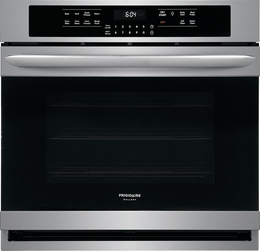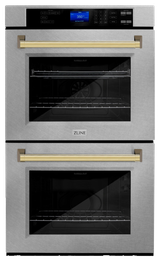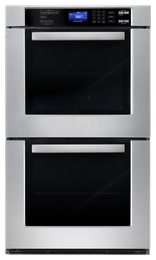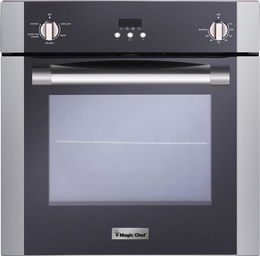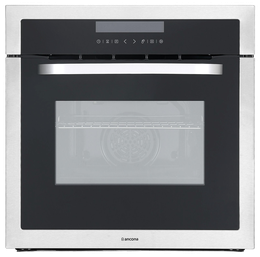FREE shipping on orders over $49!* Details
80 Results
Sort by:
Price
80 Results
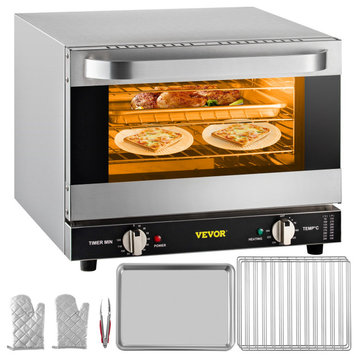
VEVOR Convection Oven Countertop Conventional Oven Electric Baking Oven, 20 Lby VEVOR
All-Round Hot Air Circulation: : Compared with deep-frying, baking with less oil and fat can help you cultivate a healthier eating habit. Aided by the 1440W power and efficient fan, our commercial countertop oven is sure to spread heat evenly throughout the body, baking foods rapidly. 2 easy-to-operate knobs precisely control the heating temp and baking time. Heating temperature range: 150-500 degrees F(65-250); Time setting: 0-120 min. You can customize the cook cycle to your specific needs.
Stainless Body and Tempered Glass Door: : The rugged stainless steel interior and exterior are extremely durable, rust and corrosion-proof, and effortless to clean. It is also equipped with a dual-wall tempered glass door, avoiding heat loss while allowing you to keep an eye on the inside cooking progress at any time. The cool-touch Al alloy handle is comfortable and secure to grip, and the oven light makes your food look attractive.
Thoughtful Details and Accessories: : Considerate details are combined on our toaster oven. The magnetic sealing strip locks the temp inside and reduces heat loss. Dense air vents facilitate airflow and dissipate heat effectively. 4 feet below can enhance our machine's stability on your tabletop. Besides, complete accessories are also provided for you to get cooking right out of the box, including 3 wire racks (13.7"x11.0"), 1 food tray, 1 bread clip, and a pair of heat-resistant gloves.
Applicable for Various Food Types: : Designed in a size of 18.9"x15.0"x15.0" (48x48x38 cm), our electric baking oven is ideal for home and commercial use, widely applied to convenience stores, snack bars, concession stands, restaurants, off-site catering operations and so on. It can quickly and easily bake delicious pizzas, bread, muffins, pastries, cookies, french fries, chickens, etc. Plus, a 120V electrical connection is required for this device.
$292
Free Shipping
Features and Details
19Qt/21L Spacious Interior: : Despite its compact structure, our commercial convection oven features a 19 Qt (21 L) inner capacity, perfectly sized to cook a small batch of delicious foods. The dimensions of the 3-tier interior reach 14.2"x13.0"x8.7" (36x33x22 cm), ideally meeting the needs of a family of three.All-Round Hot Air Circulation: : Compared with deep-frying, baking with less oil and fat can help you cultivate a healthier eating habit. Aided by the 1440W power and efficient fan, our commercial countertop oven is sure to spread heat evenly throughout the body, baking foods rapidly. 2 easy-to-operate knobs precisely control the heating temp and baking time. Heating temperature range: 150-500 degrees F(65-250); Time setting: 0-120 min. You can customize the cook cycle to your specific needs.
Stainless Body and Tempered Glass Door: : The rugged stainless steel interior and exterior are extremely durable, rust and corrosion-proof, and effortless to clean. It is also equipped with a dual-wall tempered glass door, avoiding heat loss while allowing you to keep an eye on the inside cooking progress at any time. The cool-touch Al alloy handle is comfortable and secure to grip, and the oven light makes your food look attractive.
Thoughtful Details and Accessories: : Considerate details are combined on our toaster oven. The magnetic sealing strip locks the temp inside and reduces heat loss. Dense air vents facilitate airflow and dissipate heat effectively. 4 feet below can enhance our machine's stability on your tabletop. Besides, complete accessories are also provided for you to get cooking right out of the box, including 3 wire racks (13.7"x11.0"), 1 food tray, 1 bread clip, and a pair of heat-resistant gloves.
Applicable for Various Food Types: : Designed in a size of 18.9"x15.0"x15.0" (48x48x38 cm), our electric baking oven is ideal for home and commercial use, widely applied to convenience stores, snack bars, concession stands, restaurants, off-site catering operations and so on. It can quickly and easily bake delicious pizzas, bread, muffins, pastries, cookies, french fries, chickens, etc. Plus, a 120V electrical connection is required for this device.
Specifications
- Model: FD-21
- Voltage: 120V/60Hz
- Power: 1440 W
- Amps: 12 A
- Capacity: 19 Qt / 21 L
- Number of Layers: 3
- Heating Temp Range: 150-500 degrees F / 65-250
- Timer: 0-120 min
- Material: Stainless Steel + Tempered Glass
- Wire Rack Size: 13.7"x11.0" / 34.8x28 cm
- Interior Dimensions: 14.2"x13.0"x8.7" / 36x33x22 cm
- Exterior Dimensions: 18.9"x15.0"x15.0" / 48x48x38 cm
- Product Weight: 32.4 lbs / 14.7 kg
- Package Content
- 1 x Commercial Convection Oven
- 3 x Wire Racks
- 1 x Food Tray
- 1 x Bread Clip
- 1 x Pair of Gloves
- 1 x User Manual
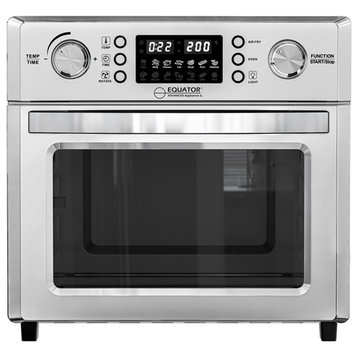
Equator 0.9cu.ft.Air Fryer+Convection Oven+Pizza Oven+Grill+Dehydrator Stainlessby Conserv By Equator
SALE
$184$231
Free Shipping
The Equator AF500 AirFyer is the last all-in-one countertop appliance you'll ever need! Elevate fries, chicken wings, and onion rings to healthy, crispy perfection, but this super-smart appliance is equipped with 15 one-push cooking functions to handle all your favorites meals without the added fat. From perfectly baked pizza, char-grilled steaks, rotisserie chicken, and melt-in-your-mouth cookies, the gourmet possibilities are endless. An air fry basket, wire rack, baking tray, rotisserie cage, and several more essential accessories are included. You'll never be wondering what to make for dinner with the Equator Air Fryer!
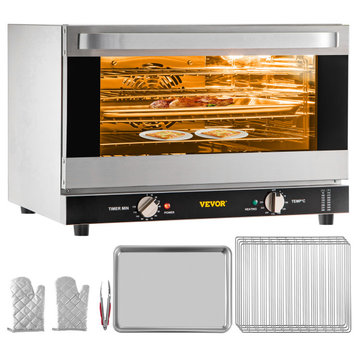
VEVOR Convection Oven Countertop Conventional Oven Electric Baking Oven, 40 Lby VEVOR
All-Round Hot Air Circulation: : Compared with deep-frying, baking with less oil and fat can help you cultivate a healthier eating habit. Aided by the 1600W power and efficient fan, our commercial countertop oven is sure to spread heat evenly throughout the body, baking foods rapidly. 2 easy-to-operate knobs precisely control the heating temp and baking time. Heating temperature range: 150-500 degrees F(65-250); Time setting: 0-120 min. You can customize the cook cycle to your specific needs.
Stainless Body and Tempered Glass Door: : The rugged stainless steel interior and exterior are extremely durable, rust and corrosion-proof, and effortless to clean. It is also equipped with a dual-wall tempered glass door, avoiding heat loss while allowing you to keep an eye on the inside cooking progress at any time. The cool-touch Al alloy handle is comfortable and secure to grip, and the oven light makes your food look attractive.
Thoughtful Details and Accessories: : Considerate details are combined on our toaster oven. The magnetic sealing strip locks the temp inside and reduces heat loss. Dense air vents facilitate airflow and dissipate heat effectively. 4 feet below can enhance our machine's stability on your tabletop. Besides, complete accessories are also provided for you to get cooking right out of the box, including 4 wire racks (18.1"x13.0"), 1 food tray, 1 bread clip, and a pair of heat-resistant gloves.
Applicable for Various Food Types: : Designed in a size of 22.8"x21.7"x15.7" (58x55x40 cm), our electric baking oven is ideal for home and commercial use, widely applied to convenience stores, snack bars, concession stands, restaurants, off-site catering operations and so on. It can quickly and easily bake delicious pizzas, bread, muffins, pastries, cookies, french fries, chickens, etc. Plus, a 120V electrical connection is required for this device.
$465
Free Shipping
Features and Details
43Qt/47L Spacious Interior: : Despite its compact structure, our commercial convection oven features a 43 Qt (47 L) inner capacity, perfectly sized to cook a medium batch of delicious foods. The dimensions of the 4-tier interior reach 18.5"x15.4"x9.8" (47x39x25 cm), ideally meeting the needs of parties or commercial use.All-Round Hot Air Circulation: : Compared with deep-frying, baking with less oil and fat can help you cultivate a healthier eating habit. Aided by the 1600W power and efficient fan, our commercial countertop oven is sure to spread heat evenly throughout the body, baking foods rapidly. 2 easy-to-operate knobs precisely control the heating temp and baking time. Heating temperature range: 150-500 degrees F(65-250); Time setting: 0-120 min. You can customize the cook cycle to your specific needs.
Stainless Body and Tempered Glass Door: : The rugged stainless steel interior and exterior are extremely durable, rust and corrosion-proof, and effortless to clean. It is also equipped with a dual-wall tempered glass door, avoiding heat loss while allowing you to keep an eye on the inside cooking progress at any time. The cool-touch Al alloy handle is comfortable and secure to grip, and the oven light makes your food look attractive.
Thoughtful Details and Accessories: : Considerate details are combined on our toaster oven. The magnetic sealing strip locks the temp inside and reduces heat loss. Dense air vents facilitate airflow and dissipate heat effectively. 4 feet below can enhance our machine's stability on your tabletop. Besides, complete accessories are also provided for you to get cooking right out of the box, including 4 wire racks (18.1"x13.0"), 1 food tray, 1 bread clip, and a pair of heat-resistant gloves.
Applicable for Various Food Types: : Designed in a size of 22.8"x21.7"x15.7" (58x55x40 cm), our electric baking oven is ideal for home and commercial use, widely applied to convenience stores, snack bars, concession stands, restaurants, off-site catering operations and so on. It can quickly and easily bake delicious pizzas, bread, muffins, pastries, cookies, french fries, chickens, etc. Plus, a 120V electrical connection is required for this device.
Specifications
- Model: FD-47
- Voltage: 120V/60Hz
- Power: 1600 W
- Amps: 13.3 A
- Capacity: 43 Qt / 47 L
- Number of Layers: 4
- Heating Temp Range: 150-500 degrees F / 65-250
- Timer: 0-120 min
- Material: Stainless Steel + Tempered Glass
- Wire Rack Size: 18.1"x13.0" / 46x33 cm
- Interior Dimensions: 18.5"x15.4"x9.8" / 47x39x25 cm
- Exterior Dimensions: 22.8"x21.7"x15.7" / 58x55x40 cm
- Product Weight: 43.7 lbs / 19.8 kg
- Package Content
- 1 x Commercial Convection Oven
- 4 x Wire Racks
- 1 x Food Tray
- 1 x Bread Clip
- 1 x Pair of Gloves
- 1 x User Manual
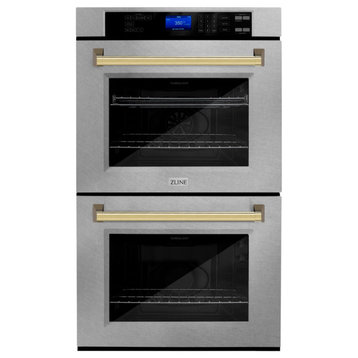
Autograh Edition DuraSnow Double Wall Oven With Gold, AWDSZ-30-Gby ZLINE Kitchen and Bath
$3,338
Free Shipping
Luxury isn't meant to be desired - it's meant to be attainable. Designed in Lake Tahoe, USA, the ZLINE 30" Autograph Edition Double Wall Oven with Self Clean and True Convection in DuraSnow Fingerprint Resistant Stainless Steel and Polished Gold (AWDSZ-30-G) provides a professional culinary experience by pairing unmatched performance with personalized touches. Encompassing limitless beauty, precision, and quality, the Autograph Edition Series creates a luxury look that will transform your space. Achieve ZLINE Attainable Luxury excellence with innovative features designed to enhance your kitchen's capability.
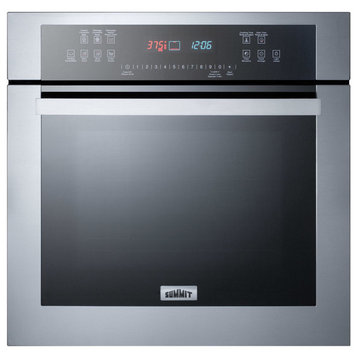
Summit SEW24SS 24"W 2.7 Cu. Ft. Single Electric Oven - Stainless Steelby Summit Lamp Corp.(21)
$1,015
Free Shipping
Features: This 2.7 cubic foot wall oven is the perfect complement to a smaller kitchen space Two (2) heavy duty gliding racks with brakes can sit on five (5) rack positions to better accommodate different sized dishes Includes a two-piece broiler tray with lid for added convenience, as well as a meat probe that can be plugged into the oven and programmed and monitored through the oven's control panel The digital control panel is easy to program, with specialty settings for baking, broiling, and convection baking or roasting Safety features include an optional automatic shutdown (12 hours for bake function, 3 hours for broil), as well as additional programming options that allow you to set a child lock or control lockout Manufacturer warranty includes 1 year parts and labor Product Technologies: Steam Clean: This unit is equipped with a steam clean function that offers a more efficient, faster solution to keeping the porcelain interior clean from new spills and soils Specifications: Total Capacity: 2.7 Cu. Ft. Broil Element: Yes Convection: Yes Sabbath Mode: Yes Cutout Depth: 25" Cutout Width: 22-3/16" Depth: 22-3/4" Height: 23-1/2" Width: 23-1/4" Amperage: 20A Voltage: 230V
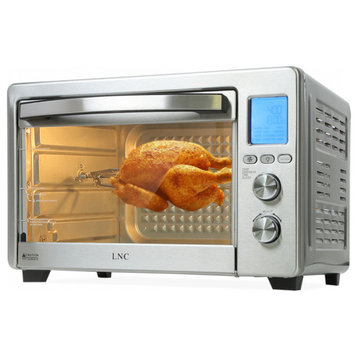
LNC Magic-Large Capacity 34 QT Digital French Door Air Fryer Toaster Ovenby LNC(1)
SALE
$245$475
Free Shipping
At LNC, we always believe that Classic is the Timeless Fashion, Liveable is the essential lifestyle, and Natural is the eternal beauty. Every product is an artwork of LNC, we strive to combine timeless design aesthetics with quality, and each piece can be a lasting appeal.
Discover a new kind of oven. This oven features air fry technology. It uses high-intensity hot air to bake, brown, and crisp your favorite fried foods to deliver deep-fried taste without the fat. With a stainless steel and black finish, it will complement any kitchen decor for a timeless look and durable performance. There are different cooking modes like toast, bake, and keeping the food warm. etc. This oven would be a very useful investment as it can satisfy many of your needs, especially for loners or people who don’t usually cook. Our product is qualified with ETL and FCC certification. With the power of 1750 watts, any dish could be heated or cooked quickly.
Discover a new kind of oven. This oven features air fry technology. It uses high-intensity hot air to bake, brown, and crisp your favorite fried foods to deliver deep-fried taste without the fat. With a stainless steel and black finish, it will complement any kitchen decor for a timeless look and durable performance. There are different cooking modes like toast, bake, and keeping the food warm. etc. This oven would be a very useful investment as it can satisfy many of your needs, especially for loners or people who don’t usually cook. Our product is qualified with ETL and FCC certification. With the power of 1750 watts, any dish could be heated or cooked quickly.
Features:
- Model: A05000S
- Number of Fry Baskets Included: 3
- Safety Listing: ETL safety listing
- Control Type: Digital
- FSeries Name: Magic
- Color/Finish Family: Stainless steel
- Canopy Dimension: 10.2"L x 4.75"W
- Oil-less: Yes
- Programmabler: Yes
- Cool-Touch Housing: No
- Basket Capacity (Quarts): 34
- Manufacturer Color/Finish: Stainless Steel
- Removable Heating Element: No
- Temperature/Cooking Controls: Yes
- Non-Stick: Yes
- Assembled Weight (lbs.): 22.5
- Cord Length (Inches): 19
- Assembled Height (Inches): 12.5
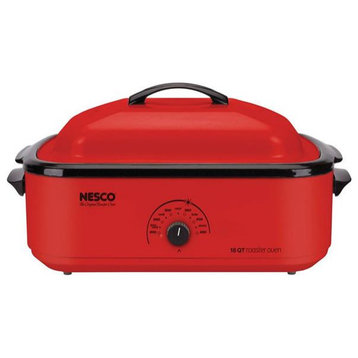
Nesco 18 qt. Chrome Red Porcelain Roaster Oven, 12x15x23.5"by Nesco
$122
Free Shipping
Chrome Red Porcelain Roaster Oven No kitchen is complete without the right set of Kitchenware products. Kitchenware is also required to store dry food, or even left overs. Now maintain your kitchen in an organized manner with the array of kitchenware. Specifications
- Capacity: 18 qt.
- Dimension: 12" x 15" x 23.5"
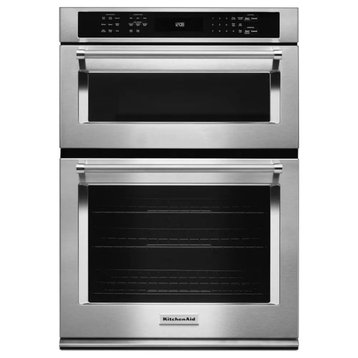
KitchenAid 30" Combination Wall Oven with Even-Heat™ True Convectionby KitchenAid
$3,572
Free Shipping
This 30" Combination Wall Oven with Even-Heat True Convection provides consistent heating and even cooking. A unique bow-tie shaped design and convection fan helps ensure there are no burnt edges or undercooked centers. Its upper Microwave Convection Cooking Oven combines a 900 watt microwave with a 1200 watt convection element for high speed cooking. Bold design details are the perfect balance of elegance and functionality.
Features:
- Even-Heat™ True Convection Oven (lower oven)
- Features a unique bow-tie design with heating element and fan that circulates hot air throughout the entire oven, providing optimal temperatures crisp, flaky baked goods, juicy, well-browned roasts and carmerlized vegetables.
- Microwave Convection Cooking (upper oven)
- Increases the speed of cooking and provides a secondary convection cooking option.
- EasyConvect™ Conversion System
- Automatically adjusts conventional baking temperatures to their convection equivalents, making it effortless to use convection with recipes of all kinds.
- Crispwave™ Microwave Technology and Crisper Pan (upper oven)
- Allows the microwave oven to be used for grilling, frying, and convection cooking. The specially designed crisper pan can be used to brown, crisp, and pan-fry foods.
- Temperature Probe
- Allows accurate measurement of internal temperatures of meats, poultry, and casseroles without having to open the oven so that food can be cooked perfectly.
- 5.0 Cu. Ft. Total Capacity (lower oven)
- Gives you an extra-large capacity for holding your largest turkeys and roasts. It also lets you prepare multiple dishes at the same time.
- 1.4 Cu. Ft. Capacity (upper oven)
- The upper microwave oven gives you family-size capacity that complements the lower convection oven.
- SatinGlide™ Roll-Out Extension Rack (lower oven)
- Allows easy loading and features an easy-grip handle, giving you the confidence when cooking with large or heavy dishes.
- FIT System Guarantee
- Allows for customization of wall oven installation to match the height of existing cabinets through flexible design elements.
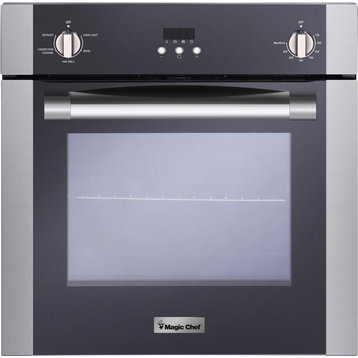
24" Built In Wall Oven, Fan Convection - Stainlessby Magic Chef(438)
$727
Free Shipping
24" Built In Wall Oven, Fan Convection - StainlessThe Magic Chef 24-inch electric wall oven offers maximum functionality in a compact space making this the ideal solution for smaller kitchens. The 2.2-cu. ft. oven capacity and two adjustable oven racks allow plenty of room to prepare family meals. The convection fan distributes heat throughout the oven cavity for quick, evenly cooked results. Plus, the sleek stainless steel and mirrored glass exterior looks great in any kitchen. Product Dimension : 23.400H x 21.400L x 23.400W
- Electrically powered to eliminate the gas leakage hazards
- Bake a delicious, home-cooked meal in the single oven for you and your family without taking up much space
- 2.20 ft of ample space so you can bake multiple sheets of biscuits simultaneously or invite the whole family to a Sunday roast
- It has a graceful stainless steel color for adding pep to your kitchen
- Oven light allows you to view food while it is cooking
- Cooling fan automatically turns on when over is hot
- Defrost function circulates air at room temperature to quickly defrost foods
- Includes broiler pan and rack that circulates air under the food
- Fan Grill mode is ideal for cooking fish steaks like swordfish and stuffed cuttlefish
- Oven light allows you to view food while it is cooking
- Cavity cooling and oven ventilation system for safe operation
- Includes broiler pan with rack that circulates air under the food
- Power Requirements: 208V ~ 60 Hz / 12 amps / 2300 watts OR 240V ~ 60 Hz / 15 amps / 2300 watts
- Color: Stainless
Kucht 30 in. Double Electric Wall Oven with Convection in Stainless Steelby KUCHT
SALE
$3,254$3,627
Free Shipping
Introducing the Kucht Double Wall Oven with Convection - a powerhouse appliance designed to elevate your cooking experience in large kitchens or as the perfect complement for kitchen setups with rangetops.
With its advanced convection feature, this electric wall oven brings a whole new level of cooking power to your culinary endeavors. Say goodbye to unevenly cooked dishes and hello to perfectly baked and broiled delights every time.
Equipped with the unique capability to bake, broil, or warm at two different temperatures simultaneously, this oven is the epitome of versatility. Ideal for high-volume kitchens, it allows you to handle multiple dishes with ease, saving you valuable time and effort.
Embrace the convenience and precision of the Kucht Double Wall Oven with Convection, and unleash your inner chef with confidence. Whether you're hosting a grand feast or preparing a family meal, this oven's exceptional performance and reliability will never disappoint. Take control of your kitchen and create culinary masterpieces like never before.
With its advanced convection feature, this electric wall oven brings a whole new level of cooking power to your culinary endeavors. Say goodbye to unevenly cooked dishes and hello to perfectly baked and broiled delights every time.
Equipped with the unique capability to bake, broil, or warm at two different temperatures simultaneously, this oven is the epitome of versatility. Ideal for high-volume kitchens, it allows you to handle multiple dishes with ease, saving you valuable time and effort.
Embrace the convenience and precision of the Kucht Double Wall Oven with Convection, and unleash your inner chef with confidence. Whether you're hosting a grand feast or preparing a family meal, this oven's exceptional performance and reliability will never disappoint. Take control of your kitchen and create culinary masterpieces like never before.
- Meat temperature probe
- Quick preheat, Sabbath, Convection cooking
- Several Cooking modes: Bake, Broil, Conv. Broil, Conv. Bake, Conv. Roast, Warm/Proof, Meats, Baked Goods, Others
- Standard side racks
- 4 glass door panels
- Touch glass control
- Self cleaning
- 4 Years Warranty for Parts & Labor - Lifetime Video Chat Support with KUCHT Specialist
Best Seller
Empava 24" Tempered Glass Digital Electric Built-in Single Wall Oven, 220vby Empava Appliances Inc.(71)
$1,349
Free Shipping
The Empava Electric Built-in Single Wall Oven, in tempered glass with mirror coating, gives you a powerful Max 3400 W, 2.3 cu. ft. oven packed with features. LED Digital touch controls with 10 functions provide a sophisticated look, are easy to clean and can be set with a simple touch, A-Class energy saving level is perfect for whole family use, this built-in single wall oven with super-bright lighting and a large oven window, you'll be able to monitor your food as it cooks for perfect meals every time. Plus, Empava safety technology
Child lock function and Forced cooling and exhaust system - ensures protect you and your family from accident at all times. And, this high-performing oven is designed and engineered in the USA to ensure the highest quality standards.
Child lock function and Forced cooling and exhaust system - ensures protect you and your family from accident at all times. And, this high-performing oven is designed and engineered in the USA to ensure the highest quality standards.
- Empava 24" Tempered Glass LED Digital Touch Controls Electric Built in Single Wall Oven 3400W 110V, Black
- Sensitive touch control
- LED Display
- 10 Functions
- A-Class energy saving level
- Tempered glass with mirror coating
- High efficient energy consumption
- Easily clean enamel inner tank
- Interior oven light
- Child lock function
- Forced cooling and exhaust system
40 Quart Capacity Counter-Top Multi-Function Intelligent Convection Steam Ovenby Whynter
$410
Free Shipping
Whynter Grande 40 Quart Capacity Counter-Top Multi-Function Intelligent Convection Steam Oven Air Fryer, Oven, Yogurt Maker, Dehydrator & DIY ModeIntended to fit any countertop space, the Whynter TSO-488GB Grande 40 Quart Capacity Counter-Top Multi-Function Intelligent Convection Oven can air fry, steam, cook, heat, roast, dry fruits, and more. The one and only cooking appliance that you will ever need in your kitchen.The Whynter TSO-488GB will prepare food 20-30% quicker than any ordinary convection broiler. Furthermore, cooking with steam allows for more nutrients to remain within your food since steaming keeps these vitamins and nutrients locked in.MULTI-FUNCTIONThis Whynter intelligent oven allows you to cook like a gourmet chef with 8 different cooking modes: Ferment, Preheat, Yogurt, Air Fry, Dehydrate, Steam, Roast, and Bake. In addition, you can customize you cooking needs by using the DIY mode!STEAM COOKINGSteam helps to lock in moisture, eliminating the need for extra oils and fats to keep food moist. No more getting trapped in the kitchen basting that turkey to keep it from drying out! It also helps to retain the foods natural vitamins and minerals.EXTRA LARGE CAPACITYThe large 1.4 cu. ft interior has sufficient space to cook for your whole family. Regardless of whether you are roasting an entire chicken or even a turkey, steaming veggies and fish simultaneously, or baking bread and cake, you will have more than enough space to do everything.EASY TOUCH DISPLAYManage time, mode, temperature, or and kind of food preparation with a simple touch.DYNAMIC HEATING AND STEAMINGThe convection system creates optimal circulation of heat within the oven. The internal fan distributes hot air and steam evenly to ensure food is perfectly cooked on all sides.DELICIOUS AND HEALTHY FOODS FOR THE WHOLE FAMILYThe one and only cooking appliance that you will ever need in your kitchen.
- Capacity: Extra Large 40 Liter / 1.4 cu. Ft. Capacity
- Water Tank: Large capacity 1.4 liter / 47 Oz water tank
- Premium Stainless Steel Housing
- Multi-functional: Ferment | Preheat | Yogurt | Air Fry | Dehydrate | Steam | Roast | Bake | DIY | Descaling
- Heating modes: Steam | Top Heater | Bottom Heater | Back Heater Convection
- Tempered double-pane mirror glass door
- Soft touch LED control and display
- Stylish black stainless steel handle
- Interior light control
- Child lock for added safety
- Multi-layer cooking
- Dynamic heating and steaming
- Easy to clean stainless steel interior with Descaling function
- Adjustable Temperature: 85'F 450'F
- Preset Time: up to 24 hours
- Accessories: Fork Assembly, Fork Handle, Broiling/Steaming Rack, Baking Pan, Oven Mitt, and Recipe Guide
- Power: 120V/60Hz
- Maximum Power Consumption: 1800W
- Product dimensions: 20.7 W x 19.68 D x 17.32 H
- Packaging dimensions: 24 W x 22.2 D x 20.2 H
- Product Weight: 48 lbs
- UPC: 850014459116
ZLINE 30 in. Wall Oven, DuraSnow Stainless Steel, Electric, AWDS-30by ZLINE Kitchen and Bath
$3,030
Free Shipping
Luxury isn't meant to be desired - it's meant to be attainable. Designed in Lake Tahoe, USA, the ZLINE 30" Professional Double Wall Oven with Self Clean and True Convection in DuraSnow Fingerprint Resistant Stainless Steel (AWDS-30) provides a professional culinary experience by pairing unmatched performance with timeless style. Achieve ZLINE Attainable Luxury excellence with innovative features designed to enhance your kitchen's capability.
26 QT Steam Convection Oven Countertop 50 Cooking Presets -Black Stainless Steelby CRO Decor
$272
Free Shipping
Use the air fryer mode to create healthy and delicious food that is fried to a crisp. Enjoy your favorite fried foods without the calories or smells that come with frying. This versatile appliance air fries, bakes, broils, convection bakes, convection bakes, toasts and heats. 1650W motor helps cook food efficiently in the healthiest way possible by reducing fat by over 85%. The multi-functional steam air fryer oven has 50 pre-set menus, either way, this oven air fryer is designed to fully serve your whole family or friends.
Features :
- Multi-functional steam air fryer with 50 pre-set menus to meet your daily cooking needs
- Digital touch screen control for precise food temperature and time control
- Reduced preheat and cooking time and faster heat circulation in the cooking zone than conventional range ovens
- Steam and air fryer combination mode combines steam and air fryer in one cooking process to heat food evenly and lock in the juices from it for tender and juicy food
- 3-tier design provides more space to cook more foodMakes 11 lbs. of grilled chicken, 12 in. pizza, 3.3 lbs. of French fries, 6 slices of toast
- Includes grill, air fryer basket, baking pan, pick-up rack, crumb tray, broiler rack
Specifications :
- Product Dimensions : H 15.04 in, W 17.13 in, D 14.96 in
- Material : Stainless Steel
- Product Color : Black
Ancona 24" 2.47 cu.ft. Single Built-in Convection Ovenby Ancona
$1,037
Free Shipping
This spacious convection wall oven delivers full cooking capacity in a compact size. The easy-to-use touch control panel offers multiple cooking options and a wide temperature range so you can keep your food warm, roast a delicious chicken or cook the perfect pizza. With its sleek stainless steel and glass design, this built-in oven will complement any kitchen.24-inch built-in 2.47 cu.ft electric built-in convection ovenLED display with easy-to-use touch controls, digital clock, and timerPowerful 3000W oven with wide temperature range from 120°F to keep your food warm to 480°F for high heat baking and broiling;8 cooking functions including defrost; 360° Rotisserie function; Single convection fan to cook a variety of foods quickly and evenly5 adjustable rack positions and 2 removable side racks for more oven space and easier cleaning2-layer glass door; 1 standard Halogen light; Child Safety Lock; EnerGuide rated; CSA certifiedEasy to clean oven interior with protective catalytic liner, allowing you to simply wipe away grease without high heat or detergents.Includes: 1 oven rack and pan/drip tray 1 rotisserie skewer kit, 2 side racks and mounting hardware
GE® 27" Smart Built-In Single Wall Ovenby General Electric
$1,821
Free Shipping
Fit Guarantee
Replacing a similar wall oven from GE Appliances or another brand? GE wall ovens are guaranteed for an exact fit or GE Appliances will pay up to $300 toward modifications. See offer criteria and details
Replacing a similar wall oven from GE Appliances or another brand? GE wall ovens are guaranteed for an exact fit or GE Appliances will pay up to $300 toward modifications. See offer criteria and details
- Never scrub, heavy-duty racks
- Say goodbye to scrubbing thanks to never scrub heavy-duty racks, engineered to withstand a self clean cycle
- Self-Clean with optional Steam Clean
- Cleaning the oven interior has never been easier, with two cleaning options to fit your lifestyle
- Anywhere control with remote notifications
- Save time by conveniently preheating and monitoring your oven from anywhere using the SmartHQ App
- Glass touch controls
- Set temperatures quickly and clean with little effort
- 10-pass hidden bake element
- Even baking and quick cleanup are assured, with 10-pass element that heats a large cooking area and is hidden for an easy-to-wipe surface
- 8-pass broil element
- Get full broil coverage and even browning from edge to edge
- Fit Guarantee
- Never scrub, heavy-duty racks
- Self-Clean with optional Steam Clean
Empava 24" Tempered Glass Electric Built-in Single Wall Oven, 220vby Empava Appliances Inc.(67)
SALE
$845$1,165
Free Shipping
Push Button control,6 cooking functions, a-class energy saving level, tempered glass, high efficient energy consumption, easily clean enamel inner tank, interior oven light, forced cooling and exhaust system", product: 23.43" X 23.43"" X 22.64" cut out dimension: 22.24"" X 23.23"" X 22.44"". The Empava electric built- in single wall oven, in tempered glass, gives you a powerful max 2800 W, 2.3 cu. ft. oven packed with features. Mechanical control with 6 functions cooking controls are easy to use, a-class energy saving level is perfect for whole family use, this built-in single wall oven with super-bright lighting and a large oven window, you'll be able to monitor your food as it cooks for perfect meals every time. Plus, Empava safety technology -forced cooling and exhaust system- ensures protect you and your family from accident at all times. And, this high-performing oven is designed and engineered in the USA to ensure the highest quality standards.
- Product dimension: 23.43" x 23.43" x 22.64"
- 110V 2.3 cu.ft with 6 Cooking Function
- Easily clean enamel inner tank
- Interior oven light
- Forced cooling and exhaust system
ZLINE DuraSnow Stainless Steel Double Wall Oven With Matte Black, AWDSZ-30-MBby ZLINE Kitchen and Bath
$3,295
Free Shipping
Luxury isn't meant to be desired - it's meant to be attainable. Designed in Lake Tahoe, USA, the ZLINE 30" Autograph Edition Double Wall Oven with Self Clean and True Convection in DuraSnow Fingerprint Resistant Stainless Steel and Matte Black (AWDSZ-30-MB) provides a professional culinary experience by pairing unmatched performance with personalized touches. Encompassing limitless beauty, precision, and quality, the Autograph Edition Series creates a luxury look that will transform your space. Achieve ZLINE Attainable Luxury excellence with innovative features designed to enhance your kitchen's capability.
Empava 24" Electric Single Wall Oven 24WOA01by Empava Appliances Inc.(70)
$1,065
Free Shipping
Empava 24 in. Electric Single Wall Oven 24WOA01 With 2.3cu. ft. cooking capacity, 5 rack positions, a baking tray, and rack. Stain and heat discoloration-resistant surface and enamel tank only require a quick wipe-down to clean. All Empava wall ovens are equipped with triple layer tempered glass plus low-radiation coating technology. With low-radiation glass, it not only heats up your oven up to 2.5 times faster using less energy but also keeps the outside of the oven cool to touch, avoiding burns and injury, preventing children from harm. The open view oven window allows you to see your food while cooking without opening the door. The easy-to-use interface and responsive mechanical controls create bold design details that are the perfect balance of elegance and functionality to upgrade your kitchen.
High Capacity: With 2.3cu. ft. cooking capacity, 5 rack positions, a baking tray, and rack.
Easy to Clean: Stain and heat discoloration-resistant surface and enamel tank only require a quick wipe-down to clean.
Anti-scalding is Safer: All Empava wall ovens are equipped with triple layer tempered glass plus low-radiation coating technology. With low-radiation glass, it not only heats up your oven up to 2.5 times faster using less energy but also keeps the outside of the oven cool to touch, avoiding burns and injury, preventing children from harm.
Convenience and fashion: The open view oven window allows you to see your food while cooking without opening the door. The easy-to-use interface and responsive mechanical controls create bold design details that are the perfect balance of elegance and functionality to upgrade your kitchen.
Specification : Item Weight 64 pounds, Item Dimensions 23.43 x 20.67 x 23.43 inches, Capacity 2.3 Cubic Feet, Minimum Circuit Breaker Amperage 20Amp, Wattage 2000 watts, Voltage 240 Volts, Fuel type Electric, Installation Type Built-In, Mater
High Capacity: With 2.3cu. ft. cooking capacity, 5 rack positions, a baking tray, and rack.
Easy to Clean: Stain and heat discoloration-resistant surface and enamel tank only require a quick wipe-down to clean.
Anti-scalding is Safer: All Empava wall ovens are equipped with triple layer tempered glass plus low-radiation coating technology. With low-radiation glass, it not only heats up your oven up to 2.5 times faster using less energy but also keeps the outside of the oven cool to touch, avoiding burns and injury, preventing children from harm.
Convenience and fashion: The open view oven window allows you to see your food while cooking without opening the door. The easy-to-use interface and responsive mechanical controls create bold design details that are the perfect balance of elegance and functionality to upgrade your kitchen.
Specification : Item Weight 64 pounds, Item Dimensions 23.43 x 20.67 x 23.43 inches, Capacity 2.3 Cubic Feet, Minimum Circuit Breaker Amperage 20Amp, Wattage 2000 watts, Voltage 240 Volts, Fuel type Electric, Installation Type Built-In, Mater
GE® 27" Smart Built-In Double Wall Ovenby General Electric
$2,478
Free Shipping
Fit Guarantee
Replacing a similar wall oven from GE Appliances or another brand? GE wall ovens are guaranteed for an exact fit or GE Appliances will pay up to $300 toward modifications. See offer criteria and details
Replacing a similar wall oven from GE Appliances or another brand? GE wall ovens are guaranteed for an exact fit or GE Appliances will pay up to $300 toward modifications. See offer criteria and details
- Never scrub, heavy-duty racks
- Say goodbye to scrubbing thanks to never scrub heavy-duty racks, engineered to withstand a self clean cycle
- Self-Clean with optional Steam Clean
- Cleaning the oven interior has never been easier, with two cleaning options to fit your lifestyle
- Anywhere control with remote notifications
- Save time by conveniently preheating and monitoring your oven from anywhere using the SmartHQ App
- Glass touch controls
- Set temperatures quickly and clean with little effort
- 10-pass hidden bake element
- Even baking and quick cleanup are assured, with 10-pass element that heats a large cooking area and is hidden for an easy-to-wipe surface
- 8-pass broil element
- Get full broil coverage and even browning from edge to edge
- Fit Guarantee
- Never scrub, heavy-duty racks
- Self-Clean with optional Steam Clean
Kucht 30in. Single Electric Wall Oven with Convection and in Stainless Steelby KUCHT
SALE
$1,852$2,721
Free Shipping
Introducing the Kucht KWO310 Single Wall Oven - a stunning addition to our renowned rangetop line, designed with matching stainless steel finishes for a cohesive and modern look in your kitchen.
Embrace the art of cooking with precision and elegance. The Kucht KWO310 Single Wall Oven is equipped with advanced convection technology, ensuring even and consistent results with every culinary creation. From delicate pastries to perfectly broiled dishes, this oven's performance is unparalleled.
Effortlessly tailor cooking temperatures and times to suit your recipes with intuitive controls, allowing you to achieve perfect bakes and warm dishes to perfection. Elevate your kitchen's efficiency and cooking capabilities with the Kucht KWO310 Single Wall Oven, the ideal choice for those who appreciate both style and functionality.
Maximize your kitchen space and create a seamless and stylish culinary oasis with the Kucht KWO310 Single Wall Oven. Embrace the art of culinary excellence and let this exceptional appliance take your cooking experience to new heights.
Embrace the art of cooking with precision and elegance. The Kucht KWO310 Single Wall Oven is equipped with advanced convection technology, ensuring even and consistent results with every culinary creation. From delicate pastries to perfectly broiled dishes, this oven's performance is unparalleled.
Effortlessly tailor cooking temperatures and times to suit your recipes with intuitive controls, allowing you to achieve perfect bakes and warm dishes to perfection. Elevate your kitchen's efficiency and cooking capabilities with the Kucht KWO310 Single Wall Oven, the ideal choice for those who appreciate both style and functionality.
Maximize your kitchen space and create a seamless and stylish culinary oasis with the Kucht KWO310 Single Wall Oven. Embrace the art of culinary excellence and let this exceptional appliance take your cooking experience to new heights.
- Meat temperature probe
- Quick preheat, Sabbath, Convection cooking
- Several Cooking modes: Bake, Broil, Conv. Broil, Conv. Bake, Conv. Roast, Warm/Proof, Meats, Baked Goods, Others
- Standard side racks
- 4 glass door panels
- Touch glass control
- Self cleaning
- 4 Years Warranty for Parts & Labor - Lifetime Video Chat Support with KUCHT Specialist
2PC Kitchen Package with 36" Electric Cooktop & 30" Double Electric Wall Ovenby Cosmo
$3,265
Free Shipping
- Cooktop: 30" 1.6 cu.ft. Over-the-Range Microwave with Sensor Cooking
- Oven: 30" Double Electric Wall Oven With Convection and Self-Cleaning
- Cooktop: 5 Electric Surface Burners
- Cooktop: Built with SCHOTT CERAN cooktop panels -- combines the sleekness of ceramic glass with enormous heat resistance and stability.
- Cooktop: Knobs provide easy control of burner temperature settings
- Cooktop: Hot Surface Indicator Light will glow to alert any surface area that is too hot to touch
- Oven: Two spacious 5 cu. ft. capacity ovens allow you to cook more dishes at once
- Oven: 7 oven functions include Bake, Broil, Warm, Proof, Convection Bake, Convection Broil and Convection Roast
- Oven: Brilliant blue porcelain interior enhances the oven's aesthetics while also being easy to clean
- Cooktop: 36 W x 21.5 D x 2.8 H
- Oven: 29.87 W x 23.5 D x 51.1875 H
Empava 24" Built-in Gas Cooktops 24GC4B67Aby Empava Appliances Inc.
$287
Free Shipping
Empava 24 in. Built-in Gas Cooktops 24GC4B67A4 different versatile burner sizes1xDual Ring 5.2" 12000-BTU 1x 3.74" 10200-BTU,1x2.56" 6000-BTU,1x1.77" 3400-BTU), which distributes even heat for simmering, boiling, stir-frying, steaming, melting, or even caramelizing! Empava recessed gas cooktop offers you the flexibility you need to make all your favorite dishes with precision and flair. The knobs and heavy cast iron grates can be cleaned in the dishwasher for hassle-free, effortless cleaning and can maintain a brand-new look for years. The 4 World Class SABAF burner(Made in Italy) gas cooktops by Empava features one of the latest flame failure thermocouples auto shut-off protection technology that prevents gas leaks to keep your home and family safe. LPG/NG Convertible (Both Nozzles Included) delivers the same maximum BTU power as propane and natural gas cooktops. It works manually without electricity. Capable for multi-purpose such as RVs, light cooking families, small kitchens, mobile homes and outdoor use, etc.
[FLEXIBILITY]: 4 different versatile burner sizes1xDual Ring 5.2" 12000-BTU
1x 3.74" 10200-BTU,1x2.56" 6000-BTU,1x1.77" 3400-BTU), which distributes even heat for simmering, boiling, stir-frying, steaming, melting, or even caramelizing! Empava recessed gas cooktop offers you the flexibility you need to make all your favorite dishes with precision and flair.
[DURABLE MATERIAL & PREMIUM QUALITY CONSTRUCTION]: The knobs and heavy cast iron grates can be cleaned in the dishwasher for hassle-free, effortless cleaning and can maintain a brand-new look for years. The 4 World Class SABAF burner(Made in Italy) gas cooktops by Empava features one of the latest flame failure thermocouples auto shut-off protection technology that prevents gas leaks to keep your home and family safe.
[FIT MULTIPLE SITUATIONS]: LPG/NG Convertible (Both Nozzles Included) delivers the same
[FLEXIBILITY]: 4 different versatile burner sizes1xDual Ring 5.2" 12000-BTU
1x 3.74" 10200-BTU,1x2.56" 6000-BTU,1x1.77" 3400-BTU), which distributes even heat for simmering, boiling, stir-frying, steaming, melting, or even caramelizing! Empava recessed gas cooktop offers you the flexibility you need to make all your favorite dishes with precision and flair.
[DURABLE MATERIAL & PREMIUM QUALITY CONSTRUCTION]: The knobs and heavy cast iron grates can be cleaned in the dishwasher for hassle-free, effortless cleaning and can maintain a brand-new look for years. The 4 World Class SABAF burner(Made in Italy) gas cooktops by Empava features one of the latest flame failure thermocouples auto shut-off protection technology that prevents gas leaks to keep your home and family safe.
[FIT MULTIPLE SITUATIONS]: LPG/NG Convertible (Both Nozzles Included) delivers the same
GE Profile™ 30" Smart Built-In Convection Double Wall Ovenby GE Profile
Cook healthier, crispier versions of your favorite foods in less time, thanks to an air fryer right in your oven that doesn't require preheating, a basket or a special tray
Faster more even results for roasts, chicken, turkey and other special-occasion favorites, with the only cooking system that delivers true top-down convection
Replacing a similar wall oven from GE Appliances or another brand? GE wall ovens are guaranteed for an exact fit or GE Appliances will pay up to $300 toward modifications. See offer criteria and details
$3,258
Free Shipping
- Built-In WiFi, Powered by SmartHQ App
- Connect, control and manage your oven from anywhere with your smartphone or tablet (Select features require WiFi Connection) See details
- GE Profile Connect +
- Ensure your oven always has the latest features, like new Air Fry modes, with downloadable software upgrades
Cook healthier, crispier versions of your favorite foods in less time, thanks to an air fryer right in your oven that doesn't require preheating, a basket or a special tray
- Precision cooking modes
- Simplify the cooking process with precision cooking modes that automatically track progress, and make time and temperature adjustments
- Remote Temperature Probe
- Know exactly when your dish has reached the perfect internal temperature with temperature readings that you can view using the SmartHQ App
Faster more even results for roasts, chicken, turkey and other special-occasion favorites, with the only cooking system that delivers true top-down convection
- Brilliant Touch 7" Display
- A bright, interactive touch screen is easy to use and includes custom screen backgrounds, weather updates and a pop of intrigue with fun food facts
- No preheat options
- Save time with a variety of precision cooking modes that eliminate the need for preheating
- Never-scrub, heavy-duty smooth glide roller racks
- Easily remove even the heaviest dishes with a roller rack that's engineered to glide seamlessly out of the oven
- Self-clean oven with optional Steam Clean
- Let your oven do the cleaning for you with two ways to eliminate baked on messes
- 10-pass hidden bake element
- Even baking is assured with heat that covers more surface area
- 10-pass dual-broil element
- Large and small dishes brown evenly with two, full-coverage elements
- Double oven convection
- Cook more dishes at once and achieve perfectly even results with convection technology in both ovens
Replacing a similar wall oven from GE Appliances or another brand? GE wall ovens are guaranteed for an exact fit or GE Appliances will pay up to $300 toward modifications. See offer criteria and details
- Built-In WiFi, Powered by SmartHQ App
- GE Profile Connect +
- No Preheat Air Fry
Frigidaire Professional 30" Double Wall Oven with Total Convectionby Frigidaire®
$3,255
Free Shipping
The Frigidaire Professional 30" Single Wall Oven with Total Convection, features our new Total Convection system, which enables cooking modes like No Preheat, Air Fry, Slow Cook, Steam Bake, Steam Roast, Convection Bake and more! Also includes a convenient temperature probe and the ReadyCookTM Air Fry Tray. Plus, enjoy our fingerprint resistant, Smudge-ProofStainless Steel finish.
Features:
- Our most advanced and powerful convection system, Total Convection - in both ovens.
- Total Convection gives you maximum versatility in the kitchen, powering cooking modes like Air Fry, No Preheat, Slow Cook, Convection Bake, Steam Bake, Convection Roast, Steam Roast and and more!
- Start baking immediately with No Preheat
- Eliminates time wasted waiting on your oven to heat up - simply place your food in the cold oven and get to meal time, in no time. * No Preheat is best used for single-rack baking of frozen or pre-made items and food that needs to cook for longer than 10 minutes.
- Deliver all of the flavor and none of the guilt with Air Fry.
- Air Fry allows you to make healthier and delicious meals for the entire family, right in your oven.
- ReadyCook™ Air Fry Tray is included
- For perfectly crispy and delicious Air Fry results. * ReadyCook™ Air Fry Tray is not required to use Air Fry.
- Experience a hassle-free way to cook with Slow Cook
- With Slow Cook, your food cooks slowly and at a lower temperature (as low as 100° F), allowing you to lock in moisture and flavor without over or undercooking your food.
- Achieve bakery results at home with Steam Bake
- With Steam Bake, steam evenly circulates throughout the oven cavity, resulting in breads and muffins that rise higher and are light and fluffy.
- Take the guesswork out of cooking with the Temperature Probe
- The Temperature Probe monitors and alerts when the desired finished cooking temperature has been reached.
- Offers two convenient cleaning options
- Enjoy more cleaning flexibility. Select Steam Clean for a quick, 30 minute clean or choose Self Clean, which is available in 2, 3 and 4 hour cycles.
- Enjoy crispy, perfectly roasted meals with Steam Roast
- Steam Roast uses moisture to make perfectly crispy and tender meats and vegetables that are roasted to perfection.
- Better access to your meals with our Glide Rack
- Our extending Glide Rack makes it easier to monitor and lift your food out of the oven.
- Extra Large Oven Capacity
- Cook more at once with a combined 10.6 cu.ft. of oven capacity.
- Smudge-Proof® Stainless Steel
- Resists fingerprints and cleans easily.
30" Single Electric Wall Oven With True European Convection and Self-Cleaningby Cosmo Appliances
$1,554
Free Shipping
A truly remarkable oven combines modern aesthetics with professional performance This COS-30ESWC 30 inch, 5 cubic foot wall oven is made of durable stainless steel and features a bold blue porcelain interior and a sleek digital control panel for easy execution of your recipes Seven oven functions let you select the perfect setting for each recipe, and True European Convection delivers perfect, evenly cooked results every time A built-in temperature probe can be used to ensure meats are cooked to the perfect internal temperature
- Spacious 5 cu ft capacity single electric wall oven allows you to cook more dishes at once
- 7 oven functions include Bake, Broil, Warm, Proof, Convection Bake, Convection Broil, and Convection Roast
- Brilliant blue porcelain interior enhances the oven's aesthetics while also being easy to clean
- A built-in precision temperature probe measures the internal temperature of your food, such as meats; providing precise cooking results and taking all the guesswork out of cooking
- Turbo True European convection for fast cooking and even heating
- Hidden Bake Element allows for obstacle-free cleaning of the oven's floor, and distribute heat evenly throughout the oven cavity
- 2 racks with 6 possible positions for easy access to food
- Interior oven light and generously sized oven window helps you check on the progress of your cooking
- Self-cleaning oven feature for added convenience
- Sabbath mode and delay start functions let you ensure meals are ready when you need them
- 1-year warranty on parts and labor; our single electric wall oven will deliver years of reliable operation
- Refresh function
- Delay start
ROBAM R BOX CT763 Countertop Oven Air Fry, Grill, Bake and Steam, Mint Greenby Robam(2)
$649
Free Shipping
Features:
- Countertop oven with spacious interior and large 1.2L water reservoir
- Core functions includes steam, grill, bake and convection (air fry)
- Additional features include defrost, ferment, warm, cleaning, drying, sterilization and descaling
- Three levels of steam mode at 185F, 210F and 300F
- Two baking modes (fan bake and steam bake) to deliver crispy outside and tender inside
- Air fry function that offers meals with no oil and grease
- Wide temperature range from 90F to 445F to let you precisely control the temperature
- Ergonomic design with 20-degree tilted LED display that you don't need to bend down and use it
- 30 built-in recipes to cook meal with the perfect setting and temperature
- Multiple colors: Mint Green, Garnet Red and Sea Salt Blue
- Includes: steamer and baking tray (1), fryer grill (1), water absorbing ball (1), rectifier (1)
Best Seller
Cosmo 24 in. 2.5 cu. ft. Single Electric Wall Oven w/8 Functions, 24"by Cosmo Appliances(5)
$1,078
Free Shipping
Bring big style to your small kitchen with the 24 in Cosmo 8 function built-in single electric wall oven Our oven has the functionality you need to bake and roast with professional results The spacious 2.5 cubic foot oven is powered by Turbo True European Convection for fast and even cooking- air is circulated through the oven cavity around your food, preventing cold spots, and cooking more quickly and evenly than standard ovens Our wall oven was designed with safety in mind- triple layered door glass stays cool to the touch, the cavity cooling system safely dissipates heat when cooking is finished With a brushed stainless steel finish, our single electric wall oven accents any kitchen, and matches existing appliances with ease
- Spacious 2.5 cu ft. capacity single electric wall oven delivers plenty of space in a compact size
- 8 oven functions: Defrost, Turbo True European Convection, lower heater, upper and lower heater, upper and lower heater convection, full grill, double grill, double grill convection
- Integrated touch controls make cleaning the oven exterior easy; surface wipes clean with a soft cloth
- Turbo True European convection for fast cooking and even heating
- 2 oven racks can be configured between 5 positions for multi-rack cooking
- Modern cabinet pull style stainless steel handle
- Child safety control lockout built-in to our single electric wall oven
- Cavity cooling system dissipates heat from the outer surfaces of the unit, including the oven door
- Single electric wall oven has a ventilated steam outlet
- Triple-layer glass door with removable inner panel features safe cool-to-touch glass
- Extra-large oven window with dual lights to easily monitor the progress of your cooking
- Complimentary drip pan included for your convenience
- 1-year warranty on parts and labor; trust our single electric wall oven to deliver years of reliable operation
- Single electric wall oven electrical requirements: 208/240VAC, 60 Hz, 3-wire, two-phase 12-15 Amp
ROBAM R BOX CT763 Countertop Oven Air Fry, Grill, Bake and Steam, Garnet Redby Robam(2)
$649
Free Shipping
Features:
- Countertop oven with spacious interior and large 1.2L water reservoir
- Core functions includes steam, grill, bake and convection (air fry)
- Additional features include defrost, ferment, warm, cleaning, drying, sterilization and descaling
- Three levels of steam mode at 185F, 210F and 300F
- Two baking modes (fan bake and steam bake) to deliver crispy outside and tender inside
- Air fry function that offers meals with no oil and grease
- Wide temperature range from 90F to 445F to let you precisely control the temperature
- Ergonomic design with 20-degree tilted LED display that you don't need to bend down and use it
- 30 built-in recipes to cook meal with the perfect setting and temperature
- Multiple colors: Mint Green, Garnet Red and Sea Salt Blue
- Includes: steamer and baking tray (1), fryer grill (1), water absorbing ball (1), rectifier (1)
Best Seller
30" Double Electric Wall Oven Self-Cleaning With Convection, Stainless Steelby Cosmo(17)
$2,067
Free Shipping
Maximize your kitchens output with Cosmos 30-inch double electric wall oven Two 5 cu ft ovens give you the flexibility to manage multiple dishes and cooking temperatures at once, and the capacity to feed a crowd The upper oven is equipped with true European convection to bring your dishes to life faster and tastier than ever, cooking at an average of 25 cooler and 10% faster than a traditional oven Automatic convection conversion means you dont have to do the math to adjust your recipes either Our ovens are equipped with 7 different functions to make this a truly versatile appliance- Bake, Broil, Warm, Proof, Convection Bake, Convection Broil, and Convection Roast Both ovens feature our brilliant blue oven cavity finish, six oven rack positions, and a self-cleaning function to take the elbow grease out of appliance maintenance When you upgrade your kitchen with Cosmo Appliances, you bring professional quality home at factory-direct prices
- Two spacious 5 cu ft capacity ovens allow you to cook more dishes at once
- 7 oven functions include Bake, Broil, Warm, Proof, Convection Bake, Convection Broil, and Convection Roast
- Brilliant blue porcelain interior enhances the ovens aesthetics while also being easy to clean
- Turbo True European convection in the upper oven for fast cooking and even heating
- Hidden Bake Element allows for obstacle-free cleaning of the ovens floor, and distribute heat evenly throughout the oven cavity
- Interior oven lights and generously sized oven windows help you check on the progress of your cooking
- Sabbath mode and delay start functions let you ensure meals are ready when you need them
- Self-cleaning oven feature for added convenience
- 1-year warranty on parts and labor
ZLINE Stainless Steel Double Wall Oven With Champagne Bronze, AWDZ-30-CBby ZLINE Kitchen and Bath
$3,035
Free Shipping
Luxury isn't meant to be desired - it's meant to be attainable. Designed in Lake Tahoe, USA, the ZLINE 30" Autograph Edition Double Wall Oven with Self Clean and True Convection in Stainless Steel and Champagne Bronze (AWDZ-30-CB) provides a professional culinary experience by pairing unmatched performance with personalized touches. Encompassing limitless beauty, precision, and quality, the Autograph Edition Series creates a luxury look that will transform your space. Achieve ZLINE Attainable Luxury excellence with innovative features designed to enhance your kitchen's capability.
2PC Kitchen Package with 36" Electric Cooktop & 24" Electric Wall Ovenby Cosmo
Oven: Integrated touch controls make cleaning the oven exterior easy; surface wipes clean with a soft clothOven: Our wall oven was designed with safety in mind- triple layered door glass stays cool to the touch, the cavity cooling system safely dissipates heat when cooking is finished.
$2,059
Free Shipping
- Cooktop: 36"" Drop-In Electric Ceramic Glass Cooktop
- Oven: 24"" Single Electric Wall Oven with 8 Functions
- Cooktop: 5 Electric Surface Burners
- Cooktop: Built with SCHOTT CERAN cooktop panels -- combines the sleekness of ceramic glass with enormous heat resistance and stability.
- Cooktop: Knobs provide easy control of burner temperature settings
- Cooktop: Hot Surface Indicator Light will glow to alert any surface area that is too hot to touch
- Oven: Spacious 2.5 cu. ft. capacity single electric wall oven delivers plenty of space in a compact size
Oven: Integrated touch controls make cleaning the oven exterior easy; surface wipes clean with a soft clothOven: Our wall oven was designed with safety in mind- triple layered door glass stays cool to the touch, the cavity cooling system safely dissipates heat when cooking is finished.
- Cooktop: 36 W x 21.5 D x 2.8 H
- Oven: 23.4 W x 22.5 D x 23.4 H
2PC Kitchen Package with 30" Electric Cooktop & 24" Electric Wall Ovenby Cosmo(1)
$1,458
Free Shipping
- Cooktop: 30"" Drop-In Electric Ceramic Glass Cooktop
- Oven: 24"" Single Electric Wall Oven with 8 Functions
- Cooktop: 4 Electric Surface Burners
- Cooktop: Built with SCHOTT CERAN cooktop panels -- combines the sleekness of ceramic glass with enormous heat resistance and stability.
- Cooktop: Knobs provide easy control of burner temperature settings
- Cooktop: Hot Surface Indicator Light will glow to alert any surface area that is too hot to touch
- Oven: Spacious 2.5 cu. ft. capacity single electric wall oven delivers plenty of space in a compact size
- Oven: Integrated touch controls make cleaning the oven exterior easy; surface wipes clean with a soft cloth
- Cooktop: 30 W x 21.5 D x 2.8 H
- Oven: 23.4 W x 22.5 D x 23.4 H
Summit TEM610BRWY 24 Electric Range - Stainless Steel / Blackby Summit Lamp Corp.
$1,409
Free Shipping
The Summit 24 Electric Range (TEM610BRWY) is perfect for smaller kitchens that don't wish to compromise on style or functionality. A 2.9 cubic foot oven and four (4) stove top burners give you ample space to cook meals and dishes for every day and special occasions. Oven: 2.9 cu. ft. with adjustable wire shelves and viewing window Stove Top: The removable porcelain top has four (4) coil burners Stainless Steel: Easy to clean, with a striking and modern look, this range will last for years to come Storage Compartment: Have all your cookware within reach by keeping it in the convenient pull out drawer
Empava 24" Stainless Steel LED Control Panel Electric Built-In Single Wall Ovenby Empava Appliances Inc.
$1,285
Free Shipping
Your kitchen works hard, so reward it with the sleek Empava 24" Stainless Steel LED Electric Built-In Single Wall Oven. This built-in design is the definition of culinary luxury, complete with a tempered-glass front pan, 10 cooking styles and a stainless steel finish. Bring a modern update to traditional spaces with the Empava Wall Oven.
- Built-in wall oven
- 2.3 cubic foot capacity
- 3400 watts
- 10 cooking styles with convection
- Broiler and grill included
- Voltage: 220
- 30 amps breaker required
- Electrical hard wiring included (convertible to 3 prong plug)
- Color: Stainless steel
- Materials: Stainless steel
- Dimensions: W 23" x D 23.43" x H 23.43"
Best Seller
ROBAM R BOX CT763 Countertop Oven Air Fry, Grill, Bake and Steam, Sea Salt Blueby Robam(2)
$649
Free Shipping
Features:
- Countertop oven with spacious interior and large 1.2L water reservoir
- Core functions includes steam, grill, bake and convection (air fry)
- Additional features include defrost, ferment, warm, cleaning, drying, sterilization and descaling
- Three levels of steam mode at 185F, 210F and 300F
- Two baking modes (fan bake and steam bake) to deliver crispy outside and tender inside
- Air fry function that offers meals with no oil and grease
- Wide temperature range from 90F to 445F to let you precisely control the temperature
- Ergonomic design with 20-degree tilted LED display that you don't need to bend down and use it
- 30 built-in recipes to cook meal with the perfect setting and temperature
- Multiple colors: Mint Green, Garnet Red and Sea Salt Blue
- Includes: steamer and baking tray (1), fryer grill (1), water absorbing ball (1), rectifier (1)
A top-of-the-line oven is a home chef’s best friend. With so many choices — ranging from electric and gas ovens, built-in ovens, double ovens and more — it’s easy to find one that fits perfectly into your kitchen. If you’re having trouble deciding between a wide variety of models, read on for some valuable tips:
With so many options for ovens, it’s easy to get lost in all the details. Here’s a handy list of pros and cons that will help you easily decide:
• Gas: This style can be more efficient than its electric counterpart and will heat up and cook food much more quickly. However, you’ll need a gas connection and outside venting options in order to install one.
• Electric: An electric oven can be less expensive than gas and typically offers a wider selection. They might also have a larger capacity, but typically take longer to heat up and use more energy than gas ovens.
• Convection: A convection oven will cook your food quickly by moving hot air around the unit with a fan. They tend to be more expensive and are smaller due to the addition of a fan inside.
• Steam: A steam oven boils water in a built-in reservoir to create a cloud of steam that cooks food and retains moisture. Steam cooking enthusiasts claim that this method retains more flavor, texture and color, but it also loses fewer vitamins, minerals and nutrients that are naturally found in food. While these ovens will thoroughly cook meats, fish, vegetables, pasta and more, you won’t find the golden brown color on the skin of your meat that traditional cooking styles offer.
A built-in or wall oven is typically built directly into the wall of your kitchen. While traditional models are dropped or slid in between cabinetry and feature a cooking range on top, built-ins forego the cooktop for the possibility of adding an additional unit on top, creating a double oven. Some built-in models can also fit below your countertop, freeing up valuable prep space. They come in gas, electric or convection styles and range in size from 24 to 30 inches wide. If you’re considering adding a wall oven to your kitchen, be aware that they must be connected to an electrical junction box via wiring installed in your cabinetry.
We wholeheartedly agree that cleaning is a pain in the you-know-what, and luckily there are two self-cleaning options that can save you both time and energy:
• Pyrolytic: A pyrolytic oven heats up to between 900 and 1,000 degrees Fahrenheit during the cleaning cycle, which reduces all that baked on grime to ash, making it much easier to clean up. While this style allows you to drop those chemical-infused cleaners in the trash (responsibly, of course!), you’ll still want to do a quick wipe down of the inside before starting the process — this will help reduce smoke and fumes during the cleaning process. Also, be sure there’s a locking mechanism so small children can’t open the door while it’s heating up to such extreme temperatures.
• Steam: This style is lined with proprietary enamel coating, which allows the walls to release dirt when activated by steam and low heat. This method is quicker than the pyrolytic method and doesn’t require such high temperatures. While it releases less fumes, it doesn’t clean as thoroughly as your pyrolytic option.
Several bells and whistles can be added to ovens, including the ability to program a delayed start time. Other models feature oversized windows that offer a great view of your meal as it cooks, but remember, a watched pot never boils! Other features include electronic controls that allow you to set precise temperatures, and parents with younger children can opt for safety locks to keep children from opening hot ovens.
What kind of oven is best for my cooking style?
With so many options for ovens, it’s easy to get lost in all the details. Here’s a handy list of pros and cons that will help you easily decide:
• Gas: This style can be more efficient than its electric counterpart and will heat up and cook food much more quickly. However, you’ll need a gas connection and outside venting options in order to install one.
• Electric: An electric oven can be less expensive than gas and typically offers a wider selection. They might also have a larger capacity, but typically take longer to heat up and use more energy than gas ovens.
• Convection: A convection oven will cook your food quickly by moving hot air around the unit with a fan. They tend to be more expensive and are smaller due to the addition of a fan inside.
• Steam: A steam oven boils water in a built-in reservoir to create a cloud of steam that cooks food and retains moisture. Steam cooking enthusiasts claim that this method retains more flavor, texture and color, but it also loses fewer vitamins, minerals and nutrients that are naturally found in food. While these ovens will thoroughly cook meats, fish, vegetables, pasta and more, you won’t find the golden brown color on the skin of your meat that traditional cooking styles offer.
What about double or built-in ovens?
A built-in or wall oven is typically built directly into the wall of your kitchen. While traditional models are dropped or slid in between cabinetry and feature a cooking range on top, built-ins forego the cooktop for the possibility of adding an additional unit on top, creating a double oven. Some built-in models can also fit below your countertop, freeing up valuable prep space. They come in gas, electric or convection styles and range in size from 24 to 30 inches wide. If you’re considering adding a wall oven to your kitchen, be aware that they must be connected to an electrical junction box via wiring installed in your cabinetry.
I can’t stand cleaning my oven! Is there a way to make cleaning easier?
We wholeheartedly agree that cleaning is a pain in the you-know-what, and luckily there are two self-cleaning options that can save you both time and energy:
• Pyrolytic: A pyrolytic oven heats up to between 900 and 1,000 degrees Fahrenheit during the cleaning cycle, which reduces all that baked on grime to ash, making it much easier to clean up. While this style allows you to drop those chemical-infused cleaners in the trash (responsibly, of course!), you’ll still want to do a quick wipe down of the inside before starting the process — this will help reduce smoke and fumes during the cleaning process. Also, be sure there’s a locking mechanism so small children can’t open the door while it’s heating up to such extreme temperatures.
• Steam: This style is lined with proprietary enamel coating, which allows the walls to release dirt when activated by steam and low heat. This method is quicker than the pyrolytic method and doesn’t require such high temperatures. While it releases less fumes, it doesn’t clean as thoroughly as your pyrolytic option.
What other features can be added to ovens?
Several bells and whistles can be added to ovens, including the ability to program a delayed start time. Other models feature oversized windows that offer a great view of your meal as it cooks, but remember, a watched pot never boils! Other features include electronic controls that allow you to set precise temperatures, and parents with younger children can opt for safety locks to keep children from opening hot ovens.







